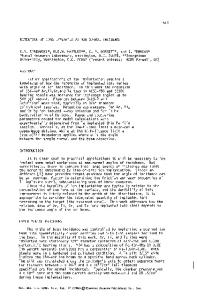Studies of III-Nitride Superlattice Structures Implanted with Lanthanide Ions
- PDF / 344,336 Bytes
- 6 Pages / 612 x 792 pts (letter) Page_size
- 71 Downloads / 404 Views
1111-D04-12
Studies of III-Nitride Superlattice Structures Implanted with Lanthanide Ions Mohammad A. Ebdah1, Wojciech M. Jadwisienczak2, Martin E. Kordesch1, Saleem Ramadan2, Hadis Morkoc3, and Andre Anders4 1 Department of Physics and Astronomy, Ohio University, Athens, OH 45701, U.S.A. 2 School of EECS, Ohio University, Athens OH, 45701, U.S.A. 3 Department of Electrical Engineering and Physics Department, Virginia Commonwealth University, Richmond, VA 23284, U.S.A. 4 Lawrence Berkeley National Laboratory, Berkeley, CA 94720, U.S.A. ABSTRACT Cathodoluminescence (CL) of rare earth (RE) ions implanted AlN/GaN superlattice (SL) structures grown by chemical vapor deposition (CVD) technique on GaN/(0001) sapphire substrate was measured at 10 K and 300 K. Implantation of terbium and thulium in SLs was done at 150 keV with a dose of up to 1×1015 cm-2 at 300 K. Samples were given post implantation isochronal thermal treatment at 900 °C in nitrogen ambient. The interface quality between the SL layers before and after implantation as well as after thermal annealing treatment has been investigated by X-ray diffraction (XRD). The characteristic satellite peaks of the SLs were measured for the (0002) reflection in the symmetric Bragg geometry for the reference, REimplanted, and annealed SLs. Furthermore, the luminescence intensity of a RE3+ ion doped AlN/GaN SL was compared with the one from RE-implanted GaN epilayers. Despite the structural damage of the AlN/GaN structures, an enhancement of the characteristic emission intensities from RE3+ ions in the SLs was observed compared to emission from RE ions in epilayers. INTRODUCTION Regardless of evident progress in research and technological achievements towards realizing RE doped III-nitride based electroluminescent devices and lasers, one must overcome difficulties in order to make these devices commercially attractive [1-4]. The most challenging obstacle on the path to achieving this goal is the low radiative quantum efficiency of RE ions in these materials. In general, the RE radiative quantum efficiency strongly depends on the carriermediated energy transfer processes, which have to compete with fast nonradiative recombination channels abundant in III-nitride hosts. It was theoretically shown that the excitation of 4f electrons near interface of heterostructures is more effective than a similar excitation in the bulk semiconductors [5, 6]. The concept of doping RE ions into quantum wells (QWs) and SLs was recently experimented and explored with Si [7], III-V and II-VI semiconductors [8,9]. These results show that the luminescence intensity of RE-doped quantum well epitaxial heterostructures is higher than in their epilayer and bulk semiconductor counterparts. As demonstrated by typical III-nitride laser diodes, light emitting diodes, and electronic devices, all GaN based devices take advantage of quantum structures such as GaN/InGaN, AlGaN/GaN and AlN/GaN [10-13]. Studies on the optically active RE-ion-doped III-nitride QWs and SLs are very scarce. However available data
Data Loading...










